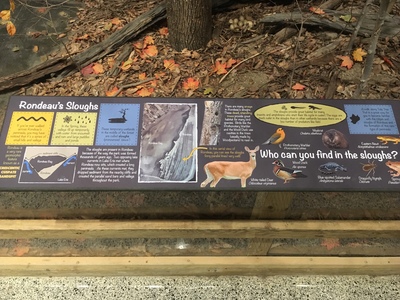
Rondeau's Sloughs
If you've ever walked across Rondeau's peninsula, you may have noticed that it's a series of small hills and valleys.
In the spring, these valleys fill up temporarily with water from snowmelt and rain and large puddles and ponds.
These temporary wetlands in the middle of the forests are called sloughs.
The sloughs are present in Rondeau because of the way the park was formed thousands of years ago.
Two opposing lake currents in Lake Erie met where Rondeau now sits, which created a long peninsula.
As these currents met, they dropped sediment from the nearby cliffs and created parallel sandbars and valleys throughout the park.
Within Rondeau's sloughs, there are many snags.
These dead, standing trees provide great habitat for many bird species.
Birds like the Prothonotary Warbler and the Wood Duck use cavities in the trees (usually made by Woodpeckers) to nest in.
There are many species to be found in the sloughs here at Rondeau.
These include the: White-Tailed Deer, Prothonotary Warbler, Wood Duck, Muskrat, Blue-Spotted Salamander, Eastern Newt, Dragonfly Nymph, and Spring Peeper.
A walk along Tulip Tree Trail is a great way for you to become familiar with the ridges and sloughs of Rondeau and the formation of this rare type of peninsula!
-
Feathered Friends of Rondeau's Marsh
-
Rondeau's Turtles
-
Fungi in the Forest
-
Carolinian Canada
-
Rondeau's Sloughs
-
The Trees of Rondeau
-
Eastern Spiny Softshell Turtle
-
Rondeau's Dunes
-
Lake Erie
-
Eastern Coyote
-
Eastern Foxsnake
-
Rondeau Snake Research
-
Eastern Newt
-
Rondeau's Invaders
-
Northern Map Turtle
-
Finale